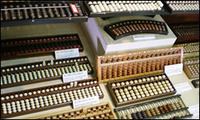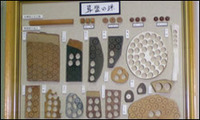

Total:131items
- Pottery & Porcelain (18)
- Lacquerware (4)
- Glasswork (2)
- Wood & Bamboo Work (19)
- Leather Work (1)
- Papermaking (13)
- Textile (20)
- Dyeing products (5)
- Masonry (1)
- Metal Work (11)
- Stationery (4)
- Accessory (4)
- Livingware (3)
- Toys & Entertainment (14)
- Interior (2)
- Other crafts (10)

 |
Main Production Site:Hyogo |
 《Characteristics》
《Characteristics》Abacus has been made as handiwork during the agricultural off-season since old time.
Especially, "Banshu Abacus" (Banshu is the old name of current Hyogo Pref., West Japan) had been well known because of mass production quantity and the high technique.
When shaving beads, craftsman is always proud of the high woodworking skills in producing the even size of bead and the precise position of bead hole. Besides the user friendliness and ease of moving the beads, the feature of beautiful appearance makes it a valuable wooden artwork.
Even now, traditional craftsmen who inherited the high traditional technique are making abacus one by one carefully by examined materials.
Abacus with colorful design or with the function besides calculation had been developed along the times.
Craftsman did not only protect the skill from the tradition and history over 400 years but also strive for a new possibility.
[A country designated traditional craft (Designated by the Minister of Economy, Trade and Industry)]
Sponsored by Ono City Dento Sangyo Kaikan
Translation by: Mana Hara, reviewed by Chan Yee Ting

| Materials | Kaba(birch), Tsuge(boxwood), Madake/Susutake (Japanese bamboos) |
|---|---|
| Crafting Processes | Banshu abacus is said that it becomes the finished product through more than 200 processes. During production, each process is performed by specialist with division of labor.
[1] Making and finishing beads Bead is said as the life of abacus. It is shaped to a unique and roundish lozenge with strong woods of birch and boxwood. [2] Making bamboo sticks Madake and Susutake are turned into the elastic bamboo sticks.. It is important to make space for beads so that they can be moved smoothly. [3] Constructing and finishing Each part is constructed by the constructing craftsman in the last process. This process is said "making the face of abacus" and let craftsman demonstrate the technique. |
| History | Abacus is said to be transmitted to Otsu (Shiga Pref., West Japan) via Nagasaki (Southern Japan) from China at around the end of Muromachi period (14-16c).
Otsu is the important point of traffic crowded with Omi (current Shiga Pref.) merchants, and because it is close to commercial areas, Osaka and Kyoto, the production of abacus was thriving. When Toyotomi Hideyoshi, later Chancellor of the Realm, captured Miki castle (located in current Hyogo Pref.) in Azuchi-Momoyama period (16-17c), residents who have escaped to Otsu acquired the technique of making abacus and began to produce it after returning to their local area. This has been said to be the beginning of the Banshu abacus. During Tenpo year (1840's), as the subcontractor of the maker in Kurumi and Omura in Miki, production of abacus beads has been started and spread in the city as a side job of farmers. Abacus became popular at the beginning of Edo period (17-19c). Children started learning "reading, writing and abacus" in Terakoya (elementary school in Edo period), then abacus widely penetrated the life of the common people. Although original abacus in China was made by round bead, it was said that the shape of beads was improved to lozenge for Japanese to move more easily at this time. The demand of abacus rapidly expanded as a tool of calculation in the education under Kokumin Kaigaku(literally, "education for all nation"), based on the issue of the educational system in 1872. The golden age of production was in 1960 and 3.6 million abacuses were produced per year. Furthermore, Banshu abacus was recognized as a traditional craft in 1976. |
| Related URL | http://densan.onocci.or.jp/ |
◆Exhibition / Showcase
Ono city Dento Sangyo Kaikan
806-1, Oji-town, Ono-city, Hyogo-Pref. 675-1378
TEL: +81-(0)794-62-3121
FAX: +81-(0)794-62-9258
(Japanese only)
Opening Hours: 9:00am-5:00pm
Closed: New Year's holiday (28th December - 4th January)
Assistance needed? For inquiries in English:
JTCO Contact Form
Your inquiries will be forwarded by JTCO in Japanese to the organization you wish to contact.



